Reversing the
Aging Process
Robert J. DeFatta, MD, PhD
Facial Plastic Surgery
DeFatta ENT & Facial Plastic Surgery
Altoona
Age is the most significant factor contributing to the overall change in the appearance of an individual’s facial features over time. This gradual process begins during the 30’s and progresses during the individual’s lifetime.
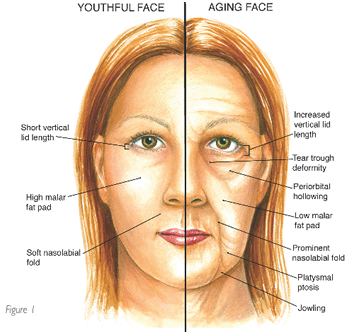 One of the earliest changes to occur is falling of the eyebrows, which creates smaller, tired appearing eyes. This is followed by skin laxity, protrusion of the fat in the upper and lower eyelids, formation of glabellar frown lines (“11s” between the eyes), and an increase in the prominence of the nasolabial folds during the 40’s. The 50’s bring deepening of forehead wrinkles, glabellar frown lines, and formation of crow’s feet. At this same time, jowling begins to occur in the lower face. In the 60’s, prominent wrinkling occurs around the mouth and the neck, the nose begins to droop and the outside corner of the eyelid weakens, causing a downward slant of the eyes. The glabellar and forehead wrinkles continue to deepen, eventually becoming evident at rest. One of the most dramatic changes in the aging process is the descent of the midface (cheek) structures due
to laxity in the skin and soft tissue, which ultimately results in a worse appearance of the region around the mouth and lower
eyelids [Figure 1].
One of the earliest changes to occur is falling of the eyebrows, which creates smaller, tired appearing eyes. This is followed by skin laxity, protrusion of the fat in the upper and lower eyelids, formation of glabellar frown lines (“11s” between the eyes), and an increase in the prominence of the nasolabial folds during the 40’s. The 50’s bring deepening of forehead wrinkles, glabellar frown lines, and formation of crow’s feet. At this same time, jowling begins to occur in the lower face. In the 60’s, prominent wrinkling occurs around the mouth and the neck, the nose begins to droop and the outside corner of the eyelid weakens, causing a downward slant of the eyes. The glabellar and forehead wrinkles continue to deepen, eventually becoming evident at rest. One of the most dramatic changes in the aging process is the descent of the midface (cheek) structures due
to laxity in the skin and soft tissue, which ultimately results in a worse appearance of the region around the mouth and lower
eyelids [Figure 1].
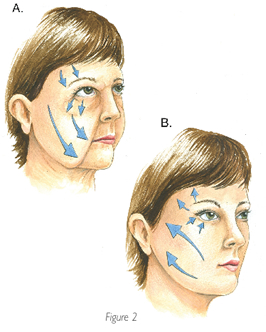 The final effect in the aging process becomes evident during the 70’s when thinning skin and fat resorption occurs throughout the face. The 80’s bring an exaggeration
of the changes that have occurred up to this time from continuing skin thinning and diminishing fat under the skin.
The final effect in the aging process becomes evident during the 70’s when thinning skin and fat resorption occurs throughout the face. The 80’s bring an exaggeration
of the changes that have occurred up to this time from continuing skin thinning and diminishing fat under the skin.
The purpose of any cosmetic procedure is to reverse the aging process that has occurred in the face. This can be accomplished through various techniques that share a common ultimate goal: repositioning facial tissues to restore a naturally more youthful and rested appearance [Figure 2]. Various procedures including facelift, brow-lift and blepharoplasty accomplish skin, subcutaneous tissue and fat pad repositioning to reverse the aging process. However, they fail to return the original volume loss, which when restored, leads to a more naturally youthful look.
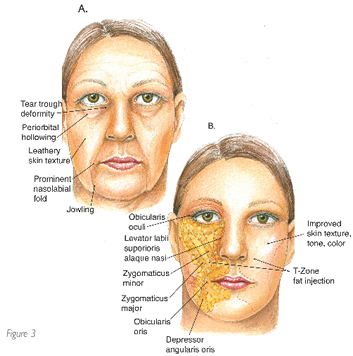 This volume loss is particularly evident in the “T zone” [Figure 3], and tends to be the primary reason for inferior outcomes in patients following facial rejuvenating procedures. Volume loss results from a combination of thinning of the fat, muscle, and skeletal framework. Over the last 10 years, combining volume restoration through lipotransfer (fat transfer) with lifting procedures has been instrumental in elevating these procedures to a new level of excellence in comprehensive facial rejuvenation.
While volume enhancement can be achieved by moving the skeletal bones or placing alloplastic cheek implants, these techniques are quite invasive and add significant morbidity and recovery time to
the procedure.
This volume loss is particularly evident in the “T zone” [Figure 3], and tends to be the primary reason for inferior outcomes in patients following facial rejuvenating procedures. Volume loss results from a combination of thinning of the fat, muscle, and skeletal framework. Over the last 10 years, combining volume restoration through lipotransfer (fat transfer) with lifting procedures has been instrumental in elevating these procedures to a new level of excellence in comprehensive facial rejuvenation.
While volume enhancement can be achieved by moving the skeletal bones or placing alloplastic cheek implants, these techniques are quite invasive and add significant morbidity and recovery time to
the procedure.
Another alternative to restoring volume in the “T zone” is through fillers, such as Juvederm, Restylane and Radiesse. Since fillers are lost over time, the patient will incur a higher financial responsibility over time when undergoing sequential procedures for the preservation of the volume enhancement with fillers alone. This restoration can be accomplished in a single setting with lipotransfer typically, and the risks of foreign body reactions to synthetic products is eliminated. The restoration of facial volume can be safely, precisely and reliably achieved by lipotransfer, which can be tailored to an individual’s specific areas of aging to achieve a more customized outcome.
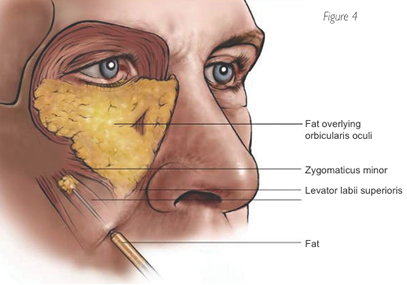 The ideal place for harvesting fat is the abdomen; however, the outer and inner thighs, flanks and outside buttocks are commonly used in thin patients. No matter how thin a patient, sufficient fat can usually be harvested to perform an effective fat transfer procedure.
The ideal place for harvesting fat is the abdomen; however, the outer and inner thighs, flanks and outside buttocks are commonly used in thin patients. No matter how thin a patient, sufficient fat can usually be harvested to perform an effective fat transfer procedure.
I routinely transfer fat to various locations in the face, including
the lower eyelids, cheeks, lips and mouth region, prejowls and the upper face (glabella, brows, crows feet area, and forehead). Fat is injected into the predetermined areas using a small, 0.9 mm cannula [Figure 4]. Multiple small incisions are made with the needle, preventing any scarring after the procedure.
Dr. DeFatta – DeFatta ENT & Facial Plastic Surgery
For information or to schedule an appointment:
715-828-2368 | www.defattaent.com
Dr. DeFatta sees patients in Altoona, Baldwin, Durand, Black River Falls, Durand, Hayward, Ladysmith, Neillsville and Stanley
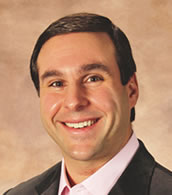


 One of the earliest changes to occur is falling of the eyebrows, which creates smaller, tired appearing eyes. This is followed by skin laxity, protrusion of the fat in the upper and lower eyelids, formation of glabellar frown lines (“11s” between the eyes), and an increase in the prominence of the nasolabial folds during the 40’s. The 50’s bring deepening of forehead wrinkles, glabellar frown lines, and formation of crow’s feet. At this same time, jowling begins to occur in the lower face. In the 60’s, prominent wrinkling occurs around the mouth and the neck, the nose begins to droop and the outside corner of the eyelid weakens, causing a downward slant of the eyes. The glabellar and forehead wrinkles continue to deepen, eventually becoming evident at rest. One of the most dramatic changes in the aging process is the descent of the midface (cheek) structures due
to laxity in the skin and soft tissue, which ultimately results in a worse appearance of the region around the mouth and lower
eyelids [Figure 1].
One of the earliest changes to occur is falling of the eyebrows, which creates smaller, tired appearing eyes. This is followed by skin laxity, protrusion of the fat in the upper and lower eyelids, formation of glabellar frown lines (“11s” between the eyes), and an increase in the prominence of the nasolabial folds during the 40’s. The 50’s bring deepening of forehead wrinkles, glabellar frown lines, and formation of crow’s feet. At this same time, jowling begins to occur in the lower face. In the 60’s, prominent wrinkling occurs around the mouth and the neck, the nose begins to droop and the outside corner of the eyelid weakens, causing a downward slant of the eyes. The glabellar and forehead wrinkles continue to deepen, eventually becoming evident at rest. One of the most dramatic changes in the aging process is the descent of the midface (cheek) structures due
to laxity in the skin and soft tissue, which ultimately results in a worse appearance of the region around the mouth and lower
eyelids [Figure 1]. 
 This volume loss is particularly evident in the “T zone” [Figure 3], and tends to be the primary reason for inferior outcomes in patients following facial rejuvenating procedures. Volume loss results from a combination of thinning of the fat, muscle, and skeletal framework. Over the last 10 years, combining volume restoration through lipotransfer (fat transfer) with lifting procedures has been instrumental in elevating these procedures to a new level of excellence in comprehensive facial rejuvenation.
While volume enhancement can be achieved by moving the skeletal bones or placing alloplastic cheek implants, these techniques are quite invasive and add significant morbidity and recovery time to
the procedure.
This volume loss is particularly evident in the “T zone” [Figure 3], and tends to be the primary reason for inferior outcomes in patients following facial rejuvenating procedures. Volume loss results from a combination of thinning of the fat, muscle, and skeletal framework. Over the last 10 years, combining volume restoration through lipotransfer (fat transfer) with lifting procedures has been instrumental in elevating these procedures to a new level of excellence in comprehensive facial rejuvenation.
While volume enhancement can be achieved by moving the skeletal bones or placing alloplastic cheek implants, these techniques are quite invasive and add significant morbidity and recovery time to
the procedure.  The ideal place for harvesting fat is the abdomen; however, the outer and inner thighs, flanks and outside buttocks are commonly used in thin patients. No matter how thin a patient, sufficient fat can usually be harvested to perform an effective fat transfer procedure.
The ideal place for harvesting fat is the abdomen; however, the outer and inner thighs, flanks and outside buttocks are commonly used in thin patients. No matter how thin a patient, sufficient fat can usually be harvested to perform an effective fat transfer procedure.